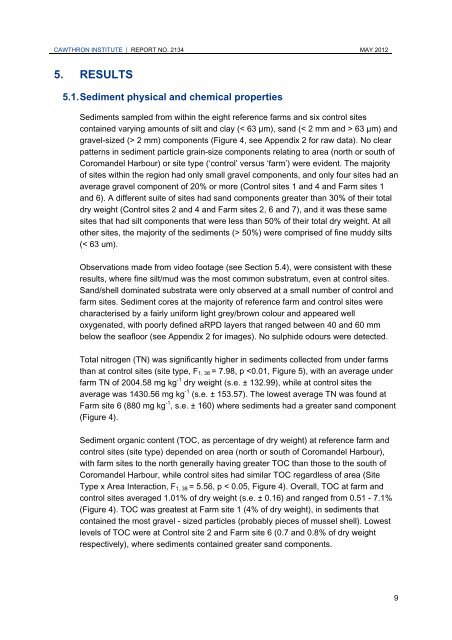Application 124771 - Ministry of Fisheries
Application 124771 - Ministry of Fisheries
Application 124771 - Ministry of Fisheries
Create successful ePaper yourself
Turn your PDF publications into a flip-book with our unique Google optimized e-Paper software.
CAWTHRON INSTITUTE | REPORT NO. 2134 MAY 2012<br />
5. RESULTS<br />
5.1. Sediment physical and chemical properties<br />
Sediments sampled from within the eight reference farms and six control sites<br />
contained varying amounts <strong>of</strong> silt and clay (< 63 µm), sand (< 2 mm and > 63 µm) and<br />
gravel-sized (> 2 mm) components (Figure 4, see Appendix 2 for raw data). No clear<br />
patterns in sediment particle grain-size components relating to area (north or south <strong>of</strong><br />
Coromandel Harbour) or site type (‘control’ versus ‘farm’) were evident. The majority<br />
<strong>of</strong> sites within the region had only small gravel components, and only four sites had an<br />
average gravel component <strong>of</strong> 20% or more (Control sites 1 and 4 and Farm sites 1<br />
and 6). A different suite <strong>of</strong> sites had sand components greater than 30% <strong>of</strong> their total<br />
dry weight (Control sites 2 and 4 and Farm sites 2, 6 and 7), and it was these same<br />
sites that had silt components that were less than 50% <strong>of</strong> their total dry weight. At all<br />
other sites, the majority <strong>of</strong> the sediments (> 50%) were comprised <strong>of</strong> fine muddy silts<br />
(< 63 um).<br />
Observations made from video footage (see Section 5.4), were consistent with these<br />
results, where fine silt/mud was the most common substratum, even at control sites.<br />
Sand/shell dominated substrata were only observed at a small number <strong>of</strong> control and<br />
farm sites. Sediment cores at the majority <strong>of</strong> reference farm and control sites were<br />
characterised by a fairly uniform light grey/brown colour and appeared well<br />
oxygenated, with poorly defined aRPD layers that ranged between 40 and 60 mm<br />
below the seafloor (see Appendix 2 for images). No sulphide odours were detected.<br />
Total nitrogen (TN) was significantly higher in sediments collected from under farms<br />
than at control sites (site type, F1, 38 = 7.98, p
















